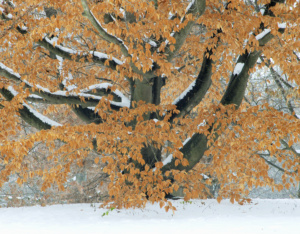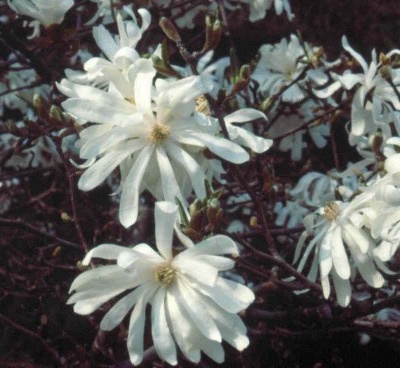Another Great American

People tend to give horticulturists too much credit, frequently assuming that we can identify every plant known to mankind in the entire world. I get pictures of various flora on a regular basis, along with the question, “Do you know what this is?” (And admittedly, it is very frustrating when I don’t). However, there’s one often asked about this time of year that I am very happy to I.D.—the American Beech, Fagus grandifolia. By mid-winter, light tan colored leaves on this tree readily stand out in our native woods, grabbing attention because they hold on until spring, thus providing interest among the bare branches common to the season. This is particularly evident on young understory specimens.
Of course, there is a technical term for the leaf-holding trait, so are you ready to learn a new word? It is called marcescence (mar-sesssense), the use of which is guaranteed to impress your friends and send your kids into eye-rolls. I’ve done both. Although beeches aren’t the only deciduous trees with persistent leaves—our native hornbeam and several oaks have this characteristic—they do it more prettily than the others, in my opinion. Also distinctive in winter are their buds: narrow, with sharp tips, the length of each covered with overlapping reddish brown scales. They are sometimes described as looking like little cigars, and really cannot be mistaken for those of any other tree.
American beech become very large in time, typically 50’-80’ and sometimes more, with wide-spreading, oval to rounded heads. Their bark is silver-gray and remains smooth even when trees are mature. Although too big for small landscapes, they are magnificent on larger properties, parks, golf courses and naturally in forests. That lovely, un-furrowed bark has long been a popular target for the carving of initials, dates, hearts, etc., much to the dismay of tree enthusiasts due to the fact that such wounds can be entry points for disease. Legendary bear hunter Daniel Boone famously recorded his kills on the bark of many a beech, earning them the moniker of “Boone Bear Trees” and the distinction as one of America’s earliest tourist attractions. Such lore harkens back to a much different time in our nation’s history—a period, for example, when beechnuts produced by these trees provided sustenance not only for an impressive array of wildlife species, but for Native Americans and emigrant pioneers as well. However, one somber reality is that, while these small nuts are still devoured by all sorts of woodland fauna, being the primary source for shelter and food for once enormous flocks of passenger pigeons is no longer required.
There are several of these notable trees growing on the Hills & Dales campus, but the oldest and most splendid are a pair that Mrs. Alice Callaway said she “dug out of the woods” as saplings. They stand side by side below the Sunken Garden, on the northern edge of the grove that buffers us from the noise of Vernon Street. If one is looking down towards the famous ‘courting bench,’ they can be seen just beyond it. Considering their current size and relatively slow growth rate, they must have been planted early after she assumed responsibility for care of the estate’s gardens and grounds. You see, American beech is a legacy tree—the type planted for future generations—with its capacity to live several hundred years, stately beauty and those delightful marcescent winter leaves serving as compensation for growing at a modest pace. Alice embraced that beautiful process of watching and waiting for the young shrubs and trees that she put in to grow into maturity. To be sure, all three of the women who loved and nurtured this garden had that same patient spirit, or it would not be here as it is today. Perhaps an abundant dose of that kind of patience is much needed these days. Perhaps just admiring these great American trees would be one good way for us to initiate its development. Even better would be to plant one. ~JP

American beech are long-lived and can become very large with age. In open areas, sizeable branches frequently emerge from the lower trunk. |

The sharp pointed, copper color buds make it easy to identify beech in the winter. |

In forest settings, American beech trees are easily recognizable in winter as they frequently retain tan colored leaves until early spring. |

The smooth grey bark of American beech is one of its most distinguishing characteristics. |
View this entire Portico Newsletter:


